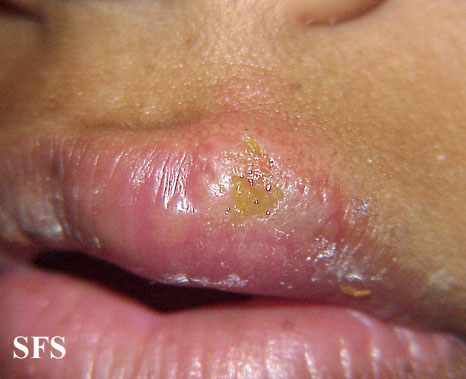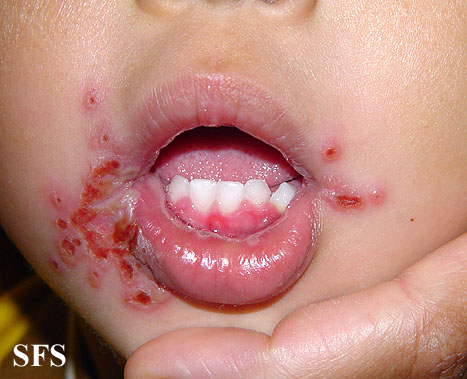Mouth Herpes (Oral) Symptoms, Pictures, Spread, Duration
What is herpes of the mouth?
Oral herpes, commonly referred to as mouth herpes, is a viral infection of the mouth and gums primarily by the Herpes simplex virus type 1 (HSV-1) but may also be due to the genital variant (HSV-2). It is also known as recurrent herpetic stomatitis or acute herpetic gingivostomatitis. The infection of the mouth typically causes small fluid-filled blisters known as vesicles on the roof of the mouth (palate), inside of the cheeks (buccal muscosa), tongue, gums and even the lips (herpes labialis). It may also occur on the skin around the mouth and extend to the nose and into the nasal cavity.
Oral herpes is also known commonly as cold sores and fever blisters but is different entity from oral canker sores although canker sores may sometimes be associated with HSV infection. Canker sores occur solely inside the mouth. Oral herpes occurs inside and around the mouth. Most of the time HSV-1 causes mouth symptoms and in a minority of cases it may also be responsible for genital symptoms. The opposite is true for HSV-2 – it causes genital symptoms in the majority of cases while only a few cases of HSV-2 infection will result in mouth symptoms. HSV-1 infection may be seen in all ages, including children, but when genital herpes is seen in children, sexual abuse needs to be a consideration.
Causes of Mouth Herpes
Spread of Oral Herpes
Herpes of the mouth is a viral infection. The virus HSV-1 may be transmitted by droplet spread – direct contact with saliva or even respiratory droplets. These droplets must make contact with broken skin or the mucous membranes in order to infect a person. The method of spread can involve kissing an infected person or even through touch. It can also be spread through the use of contaminated kitchen utensils. Sexual contact accounts for a small number of cases of HSV-1. Nevertheless it is a consideration when genital lesions are present. HSV-2 on the other hand is usually transmitted through sexual contact.
Pathophysiology of Oral Herpes
Once a person is infected, there are no symptoms for anywhere between 2 days to 2 weeks. This is known as the incubation period and is the time during which the virus multiplies profusely. The first symptoms that are seen are the small fluid-filled blisters known as vesicles. This arises as the virus starts destroying cells at the site and causes intense localized inflammation. These small vesicles or sometimes the larger bullae may either burst resulting in ulcer or heal completely with no scarring. The virus may also travel from the site of infection and “hides” by the sensory dorsal root. Here it remains latent until is it is reactivated.
Reactivation of Oral Herpes
This can occur at any time in life but tends to recur in young adults and presents as a mild cold sore. The exact reason why the infection may recur is poorly understood but it appears to be associated with one or more of the following factors.
- Emotional stress
- Trauma
- Ultraviolet light
- Extremes of temperature
- Allergies
- Upper respiratory tract infections
- Pregnancy
- Menstruation
- Suppression of the immune system
- Certain dental procedures
Signs and Symptoms of Mouth Herpes
First Infection
Primary infection presents as acute herpetic gingivostomatitis which is much more severe. The following symptoms may be present for 10 to 14 days :
- Vesicles and ulcers of sudden onset affecting the entire mouth including the gums and around the skin around the mouth
- Fever
- Swollen neck lymph nodes (specifically submandibular lymphadenopathy)
- Loss of appetite
- Headache
- Body pain
The vesicles/ulcers in this stage are widespread and painful and causes great discomfort when eating or drinking, especially hot food and beverages.
Recurring Infection
Reactivation causes milder symptoms known as recurrent herpetic stomatitis. These symptoms last for 4 to 6 days and completely resolve by day 10.
- Vesicles that may be solitary or occur in small groups and often involves the lips
- Other signs and symptoms are usually absent in a recurrence unless the person has a co-existing infection like the flu (seasonal influenza).
- Tingling, burning or itching may precede the onset of the vesicles
Pictures of Herpes in the Mouth
The pictures below were sourced from the Dermatology Atlas, courtesy of Samuel Freire da Silva, M.D.
Herpes around the mouth

Herpes labialis (herpes on the lip)

Herpes facialis (herpes of the face around the mouth)

Herpes nasalis (herpes of the nose)






